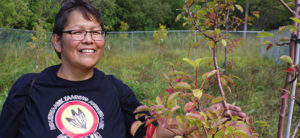Cultivating gardens to help cultivate food security and a healthy lifestyle

By Rick Garrick
Biinjitiwaabik Zaaging Anishinaabek—An orchard with four different types of fruit trees along Lake Nipigon has been created in Biinjitiwaabik Zaaging Anishinaabek (BZA) for the benefit of future generations to come.
“They were all planted by community members,” says BZA Councillor Lorraine Cook. “We had the men coming out digging the holes and the women planting [the trees]. After we planted, we had a community feast out here. We’re hoping to add a guest book out here and benches so people can come and sit.”
The community of about 337 on-Reserve band members planted 16 apple, plum, pear, and cherry trees in an area near the shoreline with a natural artesian flow of water that provides sufficient irrigation for the trees. The fruit trees were planted two years ago through funding from Health Canada.
“Next year, the third year, we can harvest,” Cook says. “Our first winter was kind of the hardest because it was the coldest, but we had them wrapped. This year we are not going to wrap them because we are trying to make them stronger now.”
Cook says the fruit trees have doubled or tripled in size since they were first planted.
“At the orchard right now you can see the cherries growing on the trees,” Cook says.
BZA plans to begin harvesting fruit from the fruit trees next year.
“Once we start getting fruit, we are planning to do classes with people to learn how to make jams, jellies, and just making preserves,” Cook says. “We need to think about our future. It’s more for food security, too.”
BZA has also created four garden cribs at the community’s medical centre and helped community members with their own gardens.
“We have 13 people with gardens in their own yards [whom] we provided seeds and topsoil to,” Cook says. “The reason why we do gardens is to promote food security and to promote people eating healthy.”
Cook says each of the gardeners offers a different skill for the community.
“That is what we tap in,” Cook says. “We know who has got the skill and that is what we use. It is all community members, community based. We’ve got to live here so we all work together as a team.”
Cook says the community’s location along Highway 11, about 40 kilometers north of the Highway 17 junction near Nipigon, could be an issue if either of the highways were closed due to accidents or weather.
“If the roads are closed, we’ve got to have [food] reserves for ourselves,” Cook says. “We’re trying to get people ready for at least 72 hours so if something goes down, like power or an accident. For example, with that Nipigon bridge [closure last winter], a lot of people weren’t ready for food [shortages]. A lot of people didn’t have milk, fresh produce. So that is why we are thinking if we grow locally, we can help our people in our First Nation.”
BZA fishers have also been harvesting walleye, whitefish, sauger, pike, and speckled trout from Lake Nipigon for generations. The community currently has two commercial fishers who operate from May to November on Lake Nipigon.
“Once the ice freezes up, they go ice fishing in the winter,” Cook says. “We have more commercial ice fishers than we do boat [fishers].”


